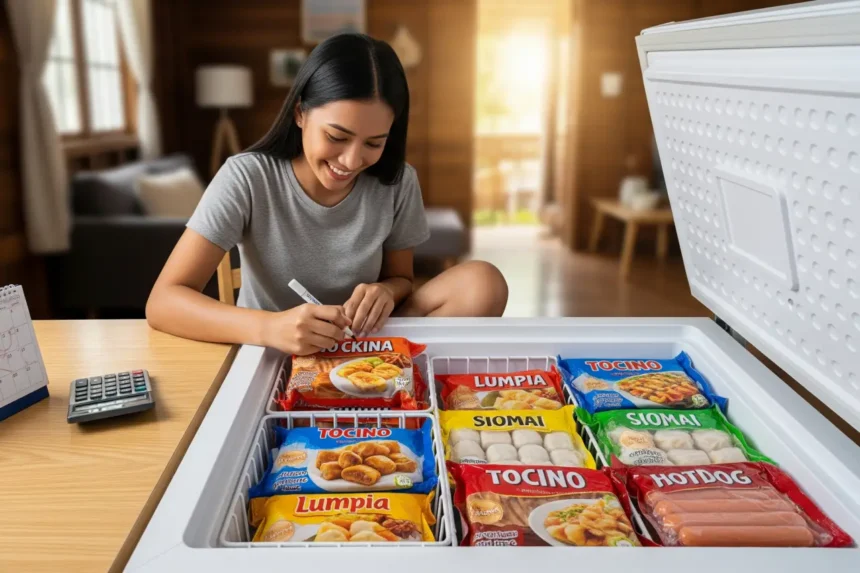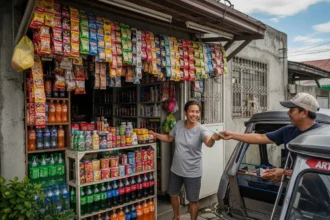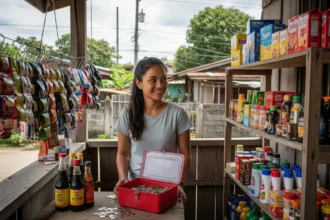Ever found yourself in the middle of a busy week, craving a delicious meal but with no time to cook? You’re not alone. More and more Filipinos are turning to frozen food as a lifesaver – quick, convenient, and always ready in the freezer. That’s why frozen food reselling in the Philippines is one of the fastest-growing small business ideas today.
- 💵 How Much Capital Do You Need to Start?
- 🤝 Finding Your Suppliers and Top-Selling Products
- 🚀 Setting Up Your Online Store & Marketing Playbook
- ✨ Managing Your Business & Scaling Up for Success
- 🚚 Delivery & Customer Service: Building Trust, One Order at a Time
- 💰 The Final Stretch: Handling Your Finances & Staying Motivated
- ⚠️ Common Mistakes of New Frozen Food Resellers
- ❓ Frequently Asked Questions
The local frozen food market is booming, projected to grow 7.5% yearly from 2025 to 2034. And the best part? You don’t need a big restaurant or huge capital to get started. With just one freezer, a reliable supplier, and some diskarteng Pinoy, you can launch your own home-based frozen food business and start earning.
This guide will walk you through everything you need – from startup capital and profit margins to finding the right suppliers, marketing online, and managing your inventory.
💵 How Much Capital Do You Need to Start?
One of the first things Pinoys ask is, “Magkano ba ang puhunan?” The good news is, you don’t need hundreds of thousands to get started. Your starting capital will depend on how big you want to go, but here’s a simple guide:
| Startup Scale | What You’ll Need | Estimated Cost |
|---|---|---|
| P5,000–P10,000 (small, home-based) | Small chest freezer (2nd hand), starter inventory of lumpia/siomai/hotdogs, basic packaging | ₱5,000–₱10,000 |
| P15,000–P30,000 (medium, growing) | Brand-new chest freezer, larger inventory (10–15 product varieties), insulated delivery bags, stickers/logo | ₱15,000–₱30,000 |
| P50,000+ (serious setup) | 2–3 freezers, wide product line, branded packaging, permits, initial online ads | ₱50,000+ |
👉 Tipid Diskarte: Many successful resellers actually start with just one freezer and a few products, then reinvest their profits to expand.
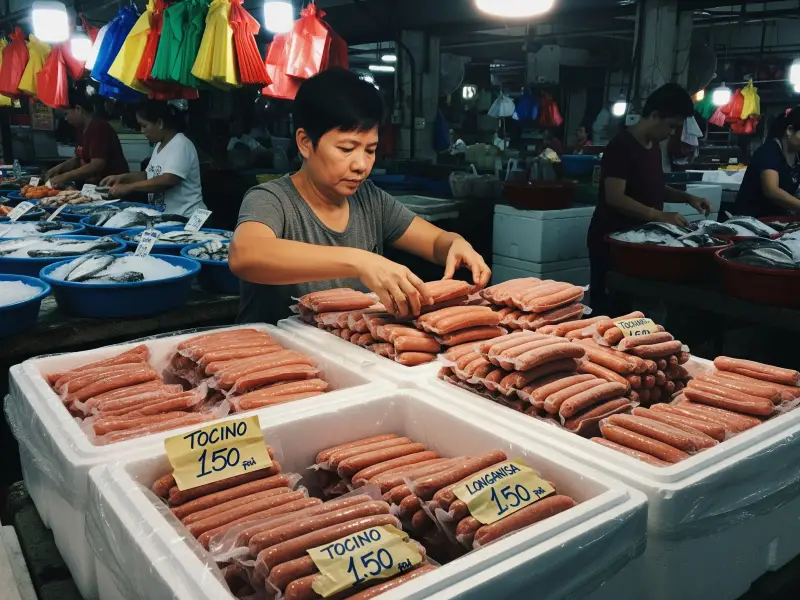
🤝 Finding Your Suppliers and Top-Selling Products
The first step in building a successful frozen food business is to identify what you’ll sell and where you’ll get it. As a reseller, your profitability depends heavily on finding reliable frozen food suppliers in the Philippines who can offer quality products at wholesale prices. The key is to choose products with a high demand among Filipinos and a good profit margin. Consider a mix of classic ready-to-cook Filipino favorites, convenient snacks, and even some premium items to cater to a wider audience.
Here’s a breakdown of popular frozen food categories to help you choose your initial product lineup:
| Product Category | Popular Filipino Examples | Target Market |
|---|---|---|
| Breakfast Essentials | Tocino, Longganisa, Skinless Longganisa, Pork Tapa, Beef Tapa | Students, young professionals, and families looking for quick and easy morning meals. |
| Merinda & Snacks | Siomai, Lumpia Shanghai, Fishballs, Kikiam, French Fries, Chicken Wings | Anyone looking for an afternoon snack, home-based workers, and families with children. |
| Main Dishes & Processed Meats | Pork and Beef Sisig, Crispy Pata, Lechon Kawali, Hungarian Sausage, Hotdogs | Home cooks who want to prepare popular dishes without the long preparation time. |
| Niche & Premium Items | Plant-based meats, imported seafood, gourmet dumplings, healthy meal preps | Health-conscious individuals, vegans/vegetarians, and customers looking for unique, high-quality products. |
Once you’ve decided on your product mix, you can start searching for wholesale frozen food suppliers. Look for those that offer easy ordering, reliable delivery, and competitive pricing.

🚀 Setting Up Your Online Store & Marketing Playbook
With your products and suppliers in place, the next crucial step is to establish your online presence. In the digital-first market of the Philippines, social media is your most powerful tool. You don’t need a complex website to start-your Facebook and Instagram pages will serve as your digital storefront.
Choose Your Platform
Most home-based frozen food businesses in the Philippines thrive on social media. Here’s a breakdown of the most popular platforms and how to use them effectively:
| Platform | Strengths | Best for… |
|---|---|---|
| Wide reach, strong community features (Groups, Marketplace), excellent for customer communication via Messenger. | Building a local following, engaging with a broad audience, and managing orders directly. | |
| Highly visual, great for showcasing food photos and videos, popular with a younger demographic. | High-quality product photography, running visually-driven campaigns, and using Reels/Stories to create buzz. | |
| Shopee/Lazada | Built-in e-commerce features, secure payment gateways, and a logistics network. | Reaching a wider, nationwide audience and establishing a more professional-looking store. |
Build Your Brand
Even as a small online food business, a strong brand can make a huge difference.
- Create a Catchy Name: Something memorable and easy to search. Think of names that are a bit playful, related to Filipino food, or easy to remember.
- Design a Simple Logo: You can use free online tools to create a simple, clean logo that looks good on social media. A good logo makes your business look more professional and trustworthy.
- Take Great Photos: Good product photos are non-negotiable. Use natural light, a clean background, and style your food to look delicious. Your goal is to make people hungry! This is crucial for social media marketing and getting those first customers to notice you.
Marketing Playbook: Get Found, Get Customers
Your digital storefront is just the start. Now, let’s get people to notice you!
- Content is King: Don’t just post product photos. Share content that provides value. You can post short videos showing how to cook your ready-to-cook meals, simple recipe ideas (like “How to cook frozen lumpia in an air fryer”), or even behind-the-scenes glimpses of your small kitchen.
- SEO is Your Friend: To get found on search engines, sprinkle relevant keywords naturally into your posts, captions, and business descriptions. Use keywords like frozen food delivery Manila, online frozen food supplier Philippines, and the names of your products (e.g., Tocino wholesale price).
- Engage with Your Community: Respond to all comments and messages promptly. Encourage customers to post reviews and photos of their meals with a unique hashtag, creating user-generated content that builds trust and social proof.
- Run Promotions: People love promos! Offer bundle deals, free delivery for minimum orders, or a “first-time buyer” discount to attract new customers. You can even run a simple online giveaway or contest to increase engagement.
Legal Requirements (Don’t Worry, Start Small)
While large-scale businesses require permits, many home-based entrepreneurs in the Philippines start small and handle the paperwork as they grow. The most important thing is to ensure your kitchen and handling practices are clean and safe. As your business grows, you can start with a Barangay Clearance, then a Mayor’s Permit, and eventually, register your online food business with the DTI and BIR to be fully compliant. Rest assured, you can be successful without all the permits at the very beginning.
Manage Orders and Delivery
Logistics can be challenging for frozen goods. Here’s what you need to master:
- Ordering System: Keep it simple at first. Use a Google Form or a direct messaging system on Facebook/Instagram to take orders. This is a great way to start, as it’s free and easy to manage.
- Packaging: Use insulated bags or styrofoam boxes with ice packs to keep products frozen during transport. This is non-negotiable for maintaining food quality and safety.
- Delivery Partners: Partner with reliable local on-demand delivery services like GrabExpress or Lalamove for quick and reliable deliveries within your area. For larger, bulk orders or far distances, you can look into services like Transportify, which offers temperature-controlled vans.
We hope these tips help you get started. Remember, a great product paired with smart marketing is the key to a successful frozen food business.
✨ Managing Your Business & Scaling Up for Success
Starting an online food business is one thing; making it grow and thrive is another. Once the orders start coming in, you’ll need to master the art of operations. This is where you build the reputation and trust that will keep customers coming back for more.
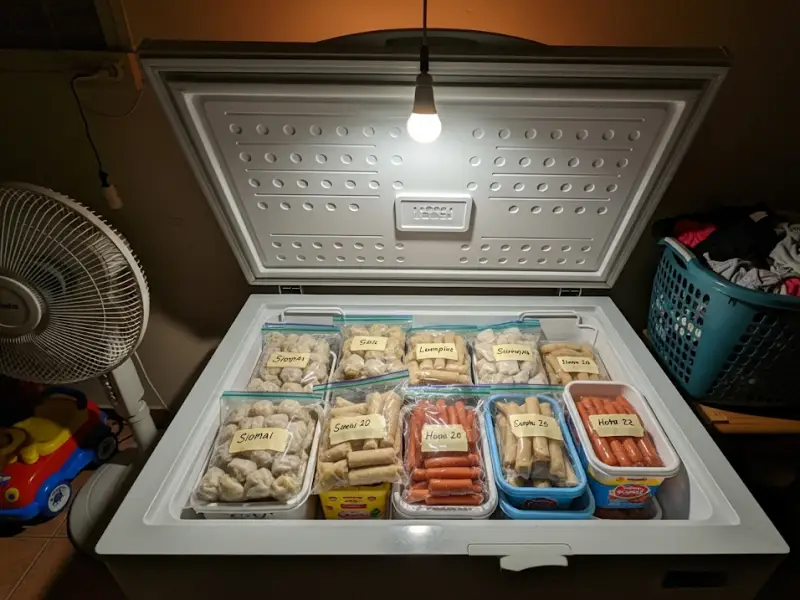
📦 Master Your Inventory and Storage
Your products are perishable, so proper inventory management is key to minimizing waste and maximizing profit.
Imagine, nag-post ka ng bagong stock ng siomai, and biglang dami ng orders! But when you check your freezer, you realize almost all of it is gone. Stressful, right? That’s why tracking your stock is a lifesaver.
- FIFO (First-In, First-Out) Method: Always sell your oldest stock first. Label your products with the date you received them so you know what to use or sell first. For example, kung may dumating kang 20 packs ng lumpia today and you still have 5 packs from last week, make sure the old 5 packs are in front so they are the first ones you sell. This simple trick prevents items from sitting in your freezer for too long and potentially going to waste.
- Organized Storage: Your freezer is your most important asset. Keep it organized. Designate specific shelves or containers for different product types (e.g., one bin for longganisa, another for siomai). This makes it easy to find what you need, especially during a busy day of packing orders.
- Track Your Stock: Keep a simple spreadsheet or a notebook to track what you have. When you sell an item, note it down. When you buy from your supplier, add it to your list. This prevents you from overselling or running out of a popular item.
⚡ Don’t Forget Recurring Costs
Starting capital is just one part of the story. Every month, you’ll also deal with regular expenses that eat into your profit. Make sure to include these in your pricing:
-
Electricity: A small chest freezer adds around ₱800–₱1,200 to your monthly bill, depending on usage.
-
Packaging: Insulated bags, plastic containers, stickers, and ice packs can add ₱3–₱10 per order.
-
Delivery Costs: Even if customers pay for delivery, sometimes you’ll absorb part of the fee for promos.
-
Maintenance: Cleaning, occasional repairs, and defrosting your freezer.
-
Spoilage/Waste: Always expect at least 5–10% product loss due to freezer burn, damaged packaging, or slow-moving stock.
👉 By tracking these hidden costs, you’ll avoid the common mistake of thinking you’re earning more than you really are.

💰 Price Your Products for Profit
Your pricing strategy should do more than just cover your costs. It should also secure a good profit margin while staying competitive. Gawin nating simple ang pag-compute. Here’s a sample calculation to make pricing easier:
| Item | Cost from Supplier | Packaging & Stickers | Delivery/Misc. | Total Cost | Target Price (30% Markup) |
|---|---|---|---|---|---|
| Lumpia Shanghai | ₱80.00 | ₱5.00 | ₱15.00 | ₱100.00 | ₱130.00 |
| Siomai (Pork) | ₱90.00 | ₱5.00 | ₱15.00 | ₱110.00 | ₱143.00 |
- Calculate Your Costs: Don’t just look at the supplier price. Add in the cost of your packaging (insulated bags, stickers), delivery fees you may absorb, and a small amount for your electricity and time. This gives you your true “landed cost.”
- Find Your Margin: A common rule of thumb is to aim for a 30-50% markup on top of your total costs. This allows you to have a healthy profit while still offering a reasonable price for your customers.
- Stay Competitive: Check out your competitors. What are they selling similar products for? Your price doesn’t have to be the cheapest, but it should be competitive. People are willing to pay a little more for great quality and excellent service.
⏳ How Long Until You Get Your Capital Back?
Every negosyo owner wants to know: “Kailan ako mababawi?” The answer depends on your sales volume and initial capital. Here’s a sample scenario:
-
Initial Capital: ₱15,000 (freezer + starter stock + packaging)
-
Average Sales/Week: ₱5,000
-
Profit Margin: 30% (₱1,500/week profit)
👉 Break-Even: In just 10–12 weeks (around 3 months), you can already recover your ₱15,000 capital. After that, most of what you earn goes straight to your bulsa as profit – as long as you keep expenses under control. For smaller setups (₱5,000 capital), some resellers recover in as fast as 4–6 weeks if products move quickly.
💛 Build Customer Loyalty
Here in the Philippines, word of mouth is powerful. A happy customer can become your best marketer, especially on social media.
- Excellent Communication: Respond to inquiries quickly and kindly. Be transparent about stock availability and delivery schedules. A simple “Salamat po!” goes a long way.
- Go the Extra Mile: Small gestures can make a huge difference. For example, you can include a personalized thank-you note, add a free sachet of toyo or chili garlic sauce, or even give a small sticker of your business logo. It’s a small touch that leaves a lasting impression.
- Handle Feedback Gracefully: If a customer has a complaint, address it professionally. Offer a solution and show that you value their feedback. This builds trust and shows that your frozen food business is reliable. For example, if a customer complains that the delivery took too long, you can offer a small discount on their next order. This shows you’re listening and you care.
📈 Ready to Scale?
As your business grows, you’ll want to think about expanding.
- Expand Your Product Lineup: Once you’ve mastered a few products, consider adding more, especially those that complement your bestsellers. For example, if your lumpia is a hit, try adding different flavors or a new type of merienda.
- Offer Bundle Deals: Create curated packages to encourage bigger purchases. Think of a “Breakfast Bundle” with Tocino, Longganisa, and Tapa or a “Movie Night Kit” with your best-selling Siomai and French Fries.
- Explore New Platforms: Once you’re comfortable with social media, you can consider creating an official store on an e-commerce platform like Shopee or Lazada to reach a nationwide audience. This gives you access to a larger customer base and their built-in logistics networks.
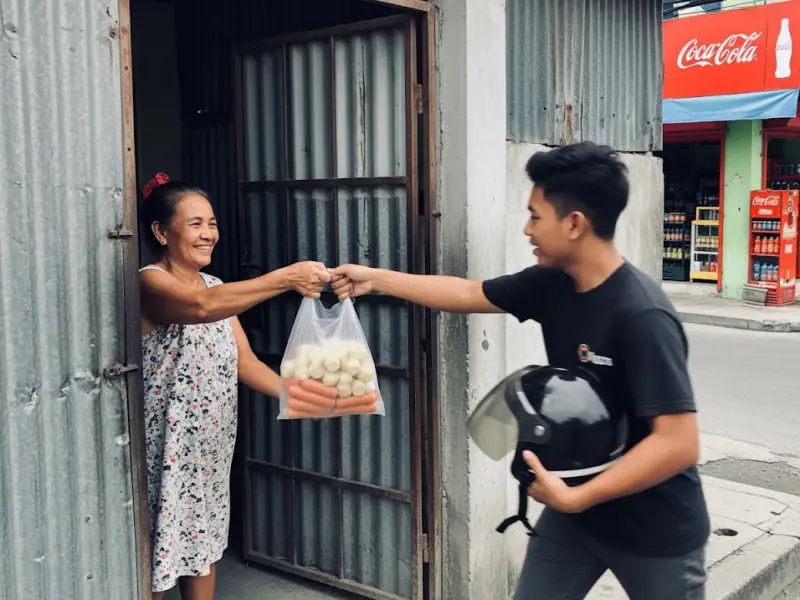
🚚 Delivery & Customer Service: Building Trust, One Order at a Time
Sabi nga nila, a great product is only half the battle. The other half is getting it into your customer’s hands in perfect condition, with a smile! Your delivery and customer service skills are what turn a one-time buyer into a loyal suki.
🛵 Your Delivery Options
You have two main choices when it comes to getting your frozen goods to your customers. Let’s compare the pros and cons to see which is best for you.
| Option | Pros | Cons | Best For… |
|---|---|---|---|
| Self-Delivery | No fees, total control over handling, you can talk directly to your customer. | Can be time-consuming, limited reach (unless you’re an expert motorcycle rider!), and it’s tiring! | Starting out, serving nearby customers, or when you only have a few orders a day. |
| Third-Party Couriers | Wide reach, convenient, less time-consuming for you, and reliable. | Delivery fees are added to the customer’s total, less control over how the package is handled. | When you have a lot of orders, expanding your delivery area, or when you just want to focus on packing. |
Para sa akin, a good strategy is to offer both. Tell your customers, “You can book your own rider po, or we can do it for you.” This gives them a choice and flexibility.
📦 Proper Packaging is Key
Remember, your number one goal is to keep the food frozen solid! Para hindi malusaw ang Siomai, you have to invest in good packaging.
- Insulated Bags: This is a non-negotiable. It keeps the cold in and the heat out.
- Bubble Wrap: Use this for delicate items to prevent them from getting squished.
- Reusable Ice Packs: These are great for keeping the temperature down during transit.
Example: If a customer in Quezon City orders Lumpia Shanghai from you in Pasig, you can’t just put it in a paper bag. You’ll need to pack it in an insulated bag, maybe with a couple of ice packs, so it arrives perfectly frozen and ready to cook.
❤️ From ‘Pabili’ to ‘Suki’: The Power of Great Service
Here in the Philippines, we value personalized service. A friendly greeting and a simple “thank you” can make a huge difference.
- Be Responsive: Reply quickly to inquiries, even if it’s just to say, “Mam, I’ll check po, I’ll get back to you in a bit.” Customers appreciate knowing that you’re there.
- Give Updates: After they book their delivery, give them a heads up. “Hello po, your order is now with the rider. Expected arrival is around 30 minutes. Salamat po!” A little update goes a long way.
- Ask for Feedback: After the delivery is done, you can send a simple message. “Hi po, did your order arrive safely? We hope you enjoy your meal! Thank you for supporting our small business.” This simple gesture makes your customers feel valued and encourages them to order again.
- Build Your Community: Don’t just see them as customers; see them as a part of your journey. You can create a Facebook group for all your “ka-foodies” where you share recipes, new products, and get feedback. This builds a strong, loyal following.
💰 The Final Stretch: Handling Your Finances & Staying Motivated
Nandito na tayo! You’ve set up your business, you’ve got your first customers, and you’re making sales. The last piece of the puzzle is to make sure your business is truly profitable and sustainable in the long run. This is about being smart with your money and keeping your energy high.
📊 Track Your Income and Expenses
Para hindi malito, you need to know exactly how much you’re earning and spending. This is a very important step towards a successful online food business. Kahit sa isang notebook lang, you should track everything.
| Income | Expenses | Notes |
|---|---|---|
| Sales from lumpia | Supplier costs for lumpia and siomai | Record the amount of each product you bought. |
| Sales from siomai | Packaging and stickers | Include bags, boxes, labels, and even a thank-you note. |
| Sales from bundles | Delivery fees | This applies if you cover the delivery fee or get a special rate. |
| Refund from a supplier | Electricity for your freezer | You can estimate this as a small percentage of your electric bill. |
| Total Income | Load for responding to inquiries | Don’t forget this little expense for communication! |
| Total Expenses | Marketing expenses (like paid ads) | If you decide to spend on social media ads, track it here. |
By tracking everything, you’ll know your real profit. This will help you decide which products are your bestsellers and which ones have the highest profit margins. Hindi mo na kailangang manghula!
🎯 Set Goals for Growth
Dream big but start small. As a frozen food reseller, your first goal might be to earn an extra ₱5,000 a month. Once you hit that, you can aim for ₱10,000, then maybe save up for a bigger freezer.
An easy way to do this is to set a “sales target” for each week. If your goal is to earn ₱1,500 in profit this week, you know you need to sell around 10-15 bundles of your products.
💖 Don’t Give Up!
Starting a business is not easy. There will be days when orders are slow, or you might feel a bit discouraged. That’s totally normal! Remember your “why”-why you started this journey in the first place. Was it to save for a vacation? To help with household expenses? To become your own boss?
Isipin mo na lang, every single sale, every positive review, and every suki is a step forward. You are building something for yourself and your family. That alone is a huge success.
Kaya mo ‘yan, ka-negosyo! The road to success is a journey, not a race. Just keep going, and soon, you’ll be a trusted name in the frozen food delivery game here in the Philippines.
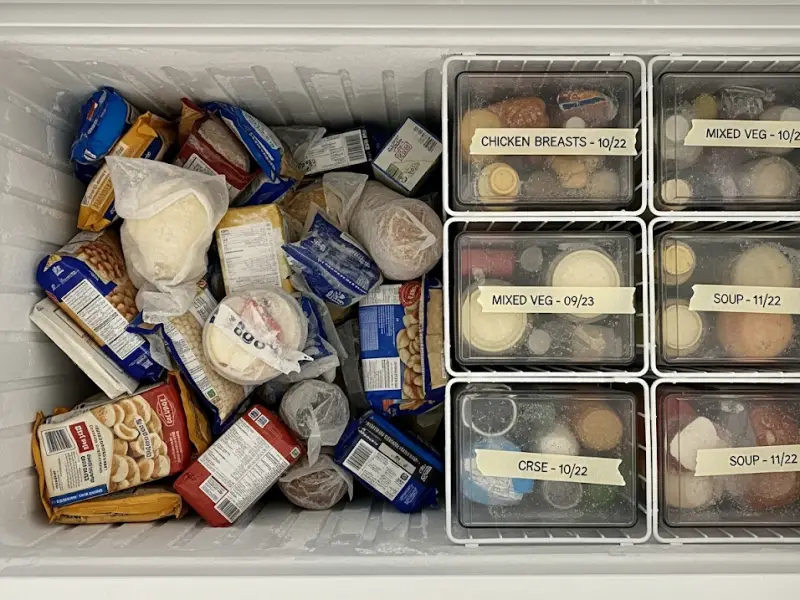
⚠️ Common Mistakes of New Frozen Food Resellers
Learn from others’ experiences para hindi ka malugi agad. Here are some pitfalls to watch out for:
-
Overstocking products that don’t sell – Always test small quantities first.
-
Forgetting to factor in electricity costs – This eats into your profit if ignored.
-
Underpricing to compete – Don’t race to the bottom; focus on quality and service.
-
Poor packaging – If products melt or look sloppy, customers won’t reorder.
-
Skipping permits forever – Okay lang to start small, but once you’re earning regularly, get permits for protection and credibility.
❓ Frequently Asked Questions
Here are some of the most common questions you might have as you begin your frozen food business journey.
- Do I need a special freezer to store frozen goods?
- No, a standard freezer or a chest freezer at home will work perfectly fine. Just make sure the temperature is consistently low to keep your products in good condition. You can get a small chest freezer once your business starts growing to handle more stock.
- What is the best way to keep my products frozen during delivery?
- The best practice is to use an insulated bag with reusable ice packs. This combination helps maintain the temperature for several hours, ensuring your products arrive in perfect condition. It’s a small investment that makes a big difference in customer satisfaction.
- How can I find a good supplier?
- You can start by looking for wholesale frozen food suppliers on Facebook, by asking for recommendations in online business groups, or by visiting a food market near you. Always check reviews and ask about their minimum order quantity and delivery options.
- How do I handle a customer complaint about a product?
- Handle it professionally and with kindness. Listen to their feedback, apologize for the inconvenience, and offer a solution like a refund or a replacement on their next order. Showing them you care will build trust and loyalty for your online food business.
- Is it a good idea to offer free delivery?
- Free delivery is a great marketing tool to attract customers, especially for a frozen food delivery business. You can offer it for a minimum order amount to encourage them to buy more products from you.
- Should I have a physical store?
- No, not at the beginning. You can operate a successful home-based food business entirely online using social media platforms. A physical store can be a long-term goal once you have a loyal customer base and enough capital.
- How do I get my first customer?
- Start by telling your family and friends about your new ready-to-cook meals and ask them to share your page. You can also run a small promo or giveaway on your social media pages to attract your first few customers.
- What’s the best way to handle payments?
- The most common methods here in the Philippines are cash on delivery (COD) for nearby customers and online transfers through apps like GCash or PayMaya. Offering both options makes it more convenient for your customers.
- How do I manage my time when the business is home-based?
- It’s all about setting a schedule. Designate specific hours for responding to inquiries, packing orders, and taking product photos. This will help you stay organized and prevent you from feeling overwhelmed.
- What if my profits are not what I expected?
- This is a good chance to re-evaluate your pricing, a key aspect of your home-based food business. Check your costs again, analyze which products sell best, and see if there are ways to lower your expenses, like buying in bulk or finding a new supplier.



